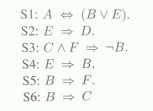
 |
CS470/570 Intro to Artificial IntelligenceChapter 7: Intro to Logical AgentsWritten Homework |
Instructions: Answers to the questions below must be presented in hardcopy, on the due date noted on the course website. All submissions must:
Typed answers are preferable, but clear handwritten work is acceptable.
Problem 1:
Consider the following knowledge base, consisting of the five propositional sentences shown:

a) Convert each of these sentences into clausal (i.e. Conjuctive Normal) form. You must show your work, i.e., the step by step transformation, justifying/labeling each step with the appropriate equivalence used.
When you are done, you have a knowledge based consisting of the sum of conjunctions in all of your converted sentences. I got a knowledge base that was a conjunction of eight total clauses (where each clause was a disjunction of primitives).
b) Use the resulting clauses to perform resolution theorem proving to prove the statement: ¬A ∧ ¬B . Note that you could make this easier by not proving the conjunction, but simply proving each of its two parts separately...and then drawing your conclusion about the truth of the confunction as a whole. Show your proof(s) in the form of a resolution tree similar to the one in Fig7.13.
7.2. A simple real-world logical puzzle. Here is a real-world logical puzzle that is just confusing enough to make a human get confused. Let's use our understanding of logic to solve it!
a) What are the basic propositions that define this problem (hint: there are 5).
b) How big is the space of models possible in this world? Make a table that shows all possible models in this space.
c) Now create your knowledge base (KB), i.e., encode the facts that are known about this world a propositional sentences (Hint: there are 4). Add these to your model table; the result should look similar to Fig.7.9.
d) Finally, use your logical representation of this world to answer the three questions posed: (1) Can you be sure than unicorns are mythical; (2) Can you be sure they are magical; (3) Can you be sure that they are horned? Explain briefly how you used your logical table to answer these questions.
7.14. Thinking about representing facts about the world...as Horn clauses.
a) For each proposed formulations, explain what the formulation is actually asserting, in plain English, clearly ruling out incorrect ones. For the correct one, make sure to explain why it's correct.
b) Hint: they can all be put into Horn clause form. Be sure that your Horn clauses contain only and, or, and not connectives (no implications, etc.)